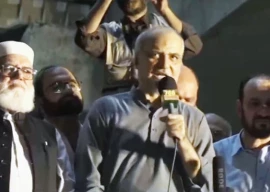
The cremation rites of these unfortunate men are to be performed by a pundit and a distant relative, as no male member is left in the two families. Women are weeping while two minors, including one three-year-old, look at the people and the dead bodies with fear and bewilderment.
These men used to sell used items every Friday in front of the mobile phone shop of Naqeem Ali, who also got injured in the blast. They used to set a stall at the market when the winter season set in. But Friday proved to be their last day of this winter.
Post Kalaya blast scenario
Erma is the village where these men used to live. They were the male members of the last three Hindu families left in the area, once worst affected by rise of militancy and subsequent military operations.
Naqeem Ali, who is also their neighbour, told The Express Tribune over phone that while other members of the Hindu community living in former tribal areas left the areas with other temporarily displaced person (TDPs) these families stayed behind due to extreme poverty and limited resources.
“Out of these three families, two have been left with no male member except for the three-year-old child of Manan, whose father and both grandfathers died in the suicide blast,” he said.
Now the remaining members of these Hindu families are also going to migrate as the Kalaya Bazaar, where they did business, has already been targeted thrice, he added.
He said Muslim also took part in the Saturday’s cremation ceremony – held by the River Indus near Attock – and showed their solidarity with the bereaved family. Minorities have suffered the most and most of them migrated after the war against militancy started, he said.
Minority in FATA
According to Baba Jee Gurpal Singh – a Sikh community notable and a Malik of the former Khyber Agency – there are 27 thousand non-Muslims including Christians, Hindus and Sikhs living in formerly Federally Administered Tribal Areas (Fata).
But a member of the Christian community, Arshid Masih, said there were fifty thousand non-Muslims before the Taliban rise in Fata, but militancy forced them to displace. Kurram, Orakzai and Khyber are areas where their numbers are higher as compared to the rest of the tribal districts.
Most members of the Sikh community who did various businesses migrated to Peshawar during the era of militancy and those who lacked capital shifted to Hasanabadal and Nankhana Sahib. However, members of the Hindu community shifted inner Pakistan and Sindh as the TDPs, Gurpal Singh said.
Singh said some 12,000 Sikhs live in Peshawar. They follow the same traditions and lifestyle as other tribal people do but they face more problems than the Muslims majority.
“We don’t have a cremation place for Hindus in the provincial capital and the Sikh community has to spend a lot at the final rituals of their loved one. Hindu cremation grounds (Shamshan Ghats) are nonexistent in the province despite repeated calls.
“We have also filed a case in the Peshawar High Court for establishing Shamshan Ghat at six K-P districts, and the decision is expected on December 5. We hope that despite government’s deceiving tactics, the court would favour us,” he said.












COMMENTS
Comments are moderated and generally will be posted if they are on-topic and not abusive.
For more information, please see our Comments FAQ